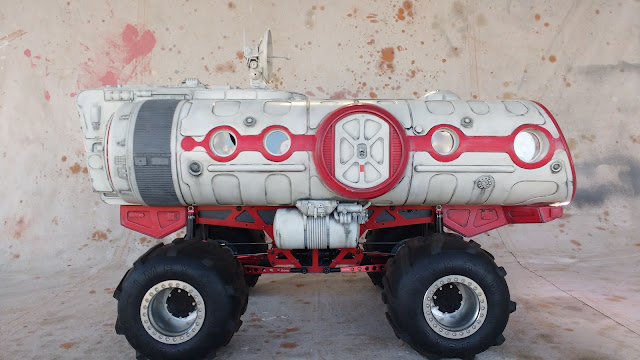The big problem was the paint, top coat and primer just came straight off the black styrene as soon as any masking tape even low-tack got anywhere near it. It flaked off in sheets. It was very depressing.
I did a bit of research to try and figure out why this occurred as it has happened to me randomly in the past. Sometimes the primer is absolutely perfectly fine and very occasionally I find it comes away with the masking. I found a very useful bit of information on you tube about the types of primer I usually use, namely car primer in an aerosol can.
Turns out there are two types available to me locally one good and one bad and I had three cans with both types represented. I sprayed the three different cans I had in sections over some black styrene and after it had dried applied some masking tape. Pulling the masking tape away was extremely revealing. The primer I had used came completely off and the other two had remained intact. The picture below shows the three cans I tested.
The can on the left was the one I used on this model which failed miserably. The other two behaved as one would hope, they stayed on the surface. It turns out the cans that say Multi Surface work very well on plastic, they even state they work on fibreglass on the back. The one that is labelled acrylic primer appears to be absolutely useless on plastic and therefore I will not use it ever again.
Before this all happened I had decided on a predominantly white finish with some sort of red stripes to match the red on the chassis. Below is the model with the base colour applied which I took into photoshop and tried out a number of various versions of red accents finally deciding on the colour rough shown in the second picture which helped to highlight the shape left between the panels that flow around the windows.
This red motif was then masked up extremely gingerly and sprayed with a small can of Ford Blaze red. The white was actually a warm off white called Antarctic white. Once that was done I re-evaluated the front end and decided that maybe the front panel needed some colour as well. So back to photoshop just to check and the colour rough that resulted shown in the second photo below was more to my liking.
My old weathering technique using a mix of Tamiya flat black and ethanol ( methylated spirits) as a dirty wash was employed. The surface is then cleaned off using a rag damp with ethanol leaving the grunge in the crevices. Dry brushing with a light grey students acrylic followed. Detailed scrapes were painted with acrylic hobby paints, a light grey surround with a dark grey core.
Another of the painting tasks was to paint the occupant figures, something I am pretty terrible at. In an attempt to try and improve in this area I watched a lot of You tube videos on figure painting in acrylics. Below is the result, still pretty poor but a lot better than my previous attempts.
The figures were superglued into their seats and the front panel screwed into position. To hide the screw heads I found a piece of red self adhesive vinyl and punched out some small circles that were pretty much the same diameter as the screw holes. The colour is not an exact match but I think it will do the job. I also used a few pieces of the red vinyl in other places on the model.
The solar panel cells on top were picked out with random squares in three shades of grey.
Finally here is the completed model.
Part 1 of this project was way back in October 2014. Part 2, 3 and 4 was a year later in October 2015. Then nothing until 2020. This project has been spread over nearly 6 years so it is satisfying to finally bring it to completion. It's also the third completed model for 2020 which as we all know has been and continues to be a very unusual and challenging year.
Thanks for looking.
More soon...




































No comments:
Post a Comment